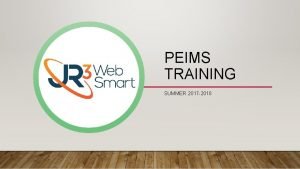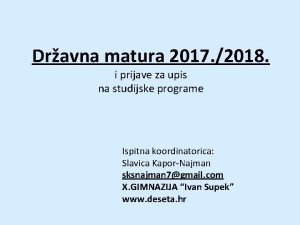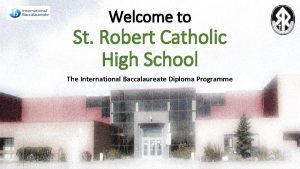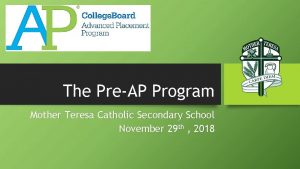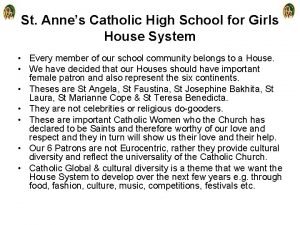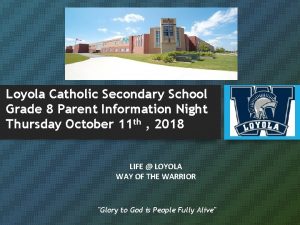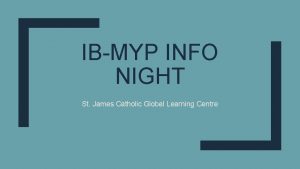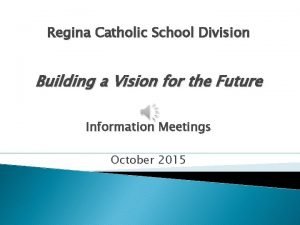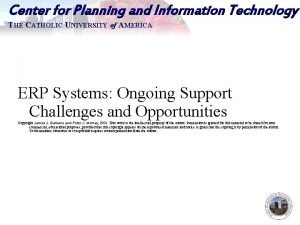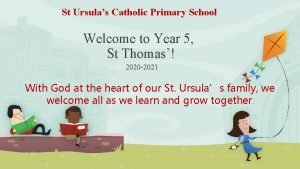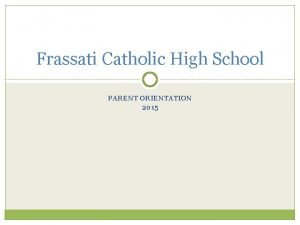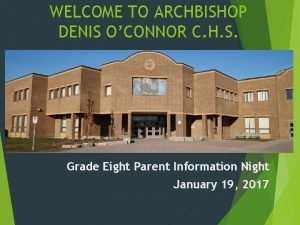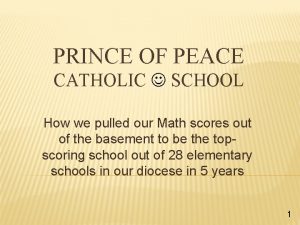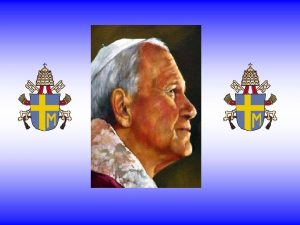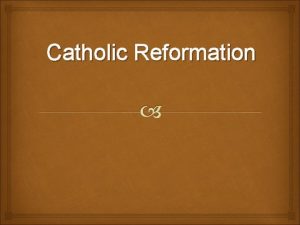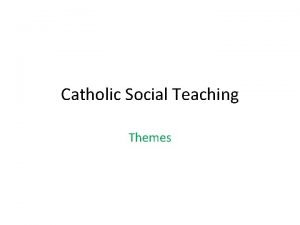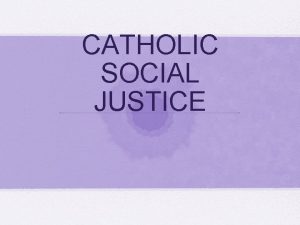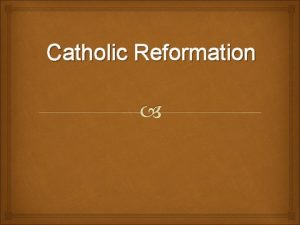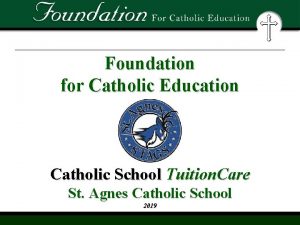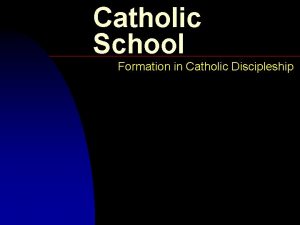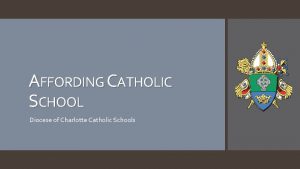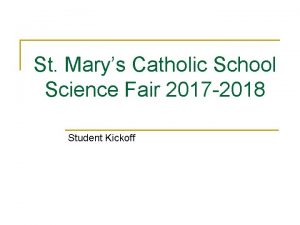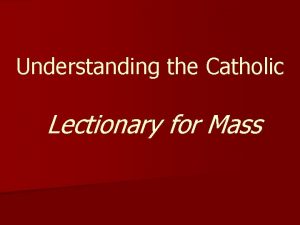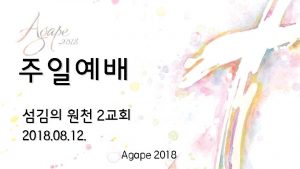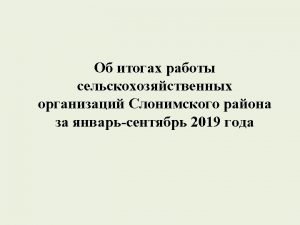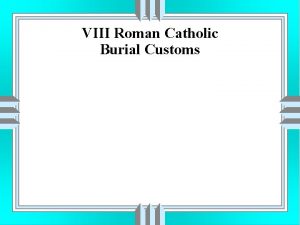JPII Catholic School z 2017 2018 Understanding the




















- Slides: 20

JPII Catholic School z 2017 -2018 Understanding the Mass

z The People and Liturgical Objects Celebrating the Mass at John Paul II Introductory Rites Liturgy of the Word Liturgy of the Eucharist Greeting First Reading Preparation of Gifts Penitential Rite Psalm Offertory Prayer Confiteor Gospel Preface and Sanctus Kyrie Homily Eucharistic Prayer Gloria Profession of Faith The Lord’s Prayer Opening Prayer of the Faithful Sign of Peace Lamb of God Communion Rite Concluding Rite

z z The People § Priest § Altar Servers § Choir § Proclaimers/Lectors § Extraordinary Minister § Deacon

z The Liturgical Objects § Altar—the place where the Holy Sacrifice is offered; it also represents Christ himself; is reverenced both at the beginning and the end of Mass § Chalice—vessel used to hold the precious blood § Chalice Veil--covering for the chalice used at Mass § Ciborium—covered container shaped like a shrine or cup used to store consecrated hosts § Corporal--square white linen cloth upon which the Sacred Host and chalice are placed

z The Liturgical Objects § Cruets—two small vessels made of glass used for containing the wine and water § Pall--the stiff square cardboard covered with lined, spread over the top of the chalice § Paten--a plate, typically made of gold or silver, used for holding the bread during the Eucharist § Processional Cross--a crucifix which is carried at the head of a procession which is usually mounted upon a long staff or handle § Purificator--a linen cloth used to wipe the chalice after celebration of the Eucharist § Sanctuary--the area around the altar which is considered holy because of the physical presence of God in the Eucharist

z The Beginning § The priest, deacon, and altar servers will enter the gym. § An altar server will lead the procession carrying the processional cross. § An entrance hymn will be sung. § We stand as the priest enters out of respect for his acting in the role of Jesus.

z Introductory Rites § § Greeting § The Mass formally begins when the priest blesses himself. § The priest will then say, “The Lord be with you. ” (Ruth 2: 4) § The congregation responds, “And with your spirit. ” Penitential Rite § The Penitential Rite is a time of reflection on one’s sins and a prayer for God’s mercy. § It focuses on our sinfulness and helps us to confess our sorrow for any wrongdoing, knowing that God is always there for us, ready to forgive. § There is a period of silence during which we think of how we’ve sinned.

z Introductory Rites § § Confiteor § We recite the Confiteor which is a prayer of general confession based on James 5: 16. § We bow our heads in shame and humility. § We strike our breast three times in imitation of the publican mentioned in Luke 18: 13. Kyrie § Kyrie is Greek for “Lord” § We are acknowledging that Jesus is Lord. § We ask the Father, the Son, and the Holy Spirit to forgive our sins.

z Introductory Rites § Gloria § The first part is from Luke 2: 13 -14; it is the song the shepherds heard sung by the angels at the birth of Christ. § The second part praises God by listing all his attributes. § The third part asks Jesus to save us from our sins. § This prayer is meant to cheer us up after we have begged during the first part of the Mass.

z Introductory Rites § Opening Prayer (The Collect) § We call upon God § We recall some deed God has done § We state our request § The prayer is made through Jesus Christ

z Liturgy of the Word § § § First Reading § Generally from the Old Testament § The lector ends with, “The word of the Lord. ” § The congregation responds, “Thanks be to God. ” Psalm § The lector reads the verses of the psalm. § The congregation repeats the response. Gospel § Read by the deacon after he receives a blessing from the priest. § We make the sign of the cross on our foreheads, our lips, and over our hearts.

z Liturgy of the Word § § Homily § The sermon given by the priest. § May explain the Scripture readings or may be used for instruction. Profession of Faith § A creed is a statement of beliefs. § Developed at the § Council of Nicea in 325 AD.

z Liturgy of the Word § Prayer of the Faithful § The general intercessions are offered by the deacon. § We pray for § The needs of the Church § Public authorities and the salvation of the whole world § Those in any difficulty, especially the poor and the sick § The local community § The faithful departed and the souls in Purgatory

z Liturgy of the Eucharist § § Preparation of Gifts § Someone from the congregation will take the bread and wine to the deacon or priest § The deacon prepares the altar § The bread and wine are blessed Offertory Prayer We ask God to accept the Sacrifice that is about to happen § To praise God § For all good § For the good of all people

z Liturgy of the Eucharist § Preface and Sanctus § The priest asks the Lord to be with us. § We ask the Lord to be with the priest. § We are asked to lift our hearts to the Lord. § Sanctus means “holy. ” § The Sanctus comes from Isaiah, Revelation, and Mark.

z Liturgy of the Eucharist § Eucharistic Prayer § Father Andrew invites us to kneel around the altar for this most holy part of the Mass. § We offer thanksgiving and acclamation. § The priest invokes the Holy Spirit upon the Eucharistic bread and wine. (epiclesis —to invoke upon) § The priest uses the words used by Jesus to consecrate the bread and wine. § We recall and reaffirms Christ’s command to, “do this in memory of me. ” (anamnesis--memorial) § The priest offers the Son to the Father with the Holy Spirit. § The priest request that the sacrifice be for the living and the dead. § The priest ends the Eucharistic Prayer with the final doxology.

z Liturgy of the Eucharist § The Lord’s Prayer § Sign of Peace § § We are brothers and sisters with those around us. § We are offering peace and forgiveness to all, even those who are far away. Lamb of God § We prepare to receive Holy Communion. § “Lord, I am not worthy that you should enter under my roof, but only say the word and my soul shall be healed. ”

z Liturgy of the Eucharist § § Communion Rite § We stand reverently in line. § We bow when the person in front of us receives the Eucharist. § Holy Communion is reserved only for Catholics who are in a state of grace and have fasted for at least an hour prior to receiving the Eucharist. § The Eucharist may be received either orally on in the hand. § We return to our seats to reflect on the gifts received. Prayer After Communion

z Liturgy of the Eucharist § Concluding Rite § We receive a final blessing. § We are told to go forth and proclaim the word of God.

z Bibliography § Dubruiel, Mike. (2007). The How-To Book of The Mass. Huntington, IN: Our Sunday Visitor Publishing Division. § Moorman, Msgr. George J. (2010). The Latin Mass Explained. Charlotte, NC: TAN Books. § Trigilio, Rev. J. , Brighenti, Rev. Kenneth, & Cafone, Rev. Msgr. James. (2011). Catholic Mass for Dummies. Hoboken, NJ: Wiley Publishing, Inc.
 Tsds peims 2017 2018
Tsds peims 2017 2018 Matura 2017/2018
Matura 2017/2018 Dada la siguiente secuencia rusia 2018 rusia 2018
Dada la siguiente secuencia rusia 2018 rusia 2018 St robert catholic high school ib boundary
St robert catholic high school ib boundary Pope paul school
Pope paul school Mother teresa catholic school
Mother teresa catholic school Annes babes house
Annes babes house St ann catholic school arlington va
St ann catholic school arlington va Lai king catholic secondary school
Lai king catholic secondary school Loyola catholic secondary school uniforms
Loyola catholic secondary school uniforms St james catholic school mississauga
St james catholic school mississauga Deshaye catholic school
Deshaye catholic school Erp technicals
Erp technicals Our lady queen of peace catholic primary school
Our lady queen of peace catholic primary school St ursula's catholic junior school
St ursula's catholic junior school Montgomery catholic powerschool
Montgomery catholic powerschool Archbishop denis o'connor catholic high school
Archbishop denis o'connor catholic high school Catholic school erp
Catholic school erp Prince of peace catholic school
Prince of peace catholic school Broughton hall catholic high school
Broughton hall catholic high school Niagara catholic summer school
Niagara catholic summer school
